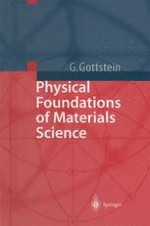2004 | OriginalPaper | Chapter
Atomic Structure of Solids
Author : Professor Dr. Günter Gottstein
Published in: Physical Foundations of Materials Science
Publisher: Springer Berlin Heidelberg
Included in: Professional Book Archive
Activate our intelligent search to find suitable subject content or patents.
Select sections of text to find matching patents with Artificial Intelligence. powered by
Select sections of text to find additional relevant content using AI-assisted search. powered by
The structural elements of matter are the atoms, which consist of a nucleus and the atomic shell. The properties of solids are essentially determined by the electron shell structure. According to the Bohr model of an atom, the electrons occupy specific orbitals (Fig. 2.1) the configuration of which, i.e. number of electrons and their spatial arrangement, follows the laws of quantum mechanics. The most important electrons for the properties of a solid are the electrons in the outermost orbital, because they determine the interaction with other atoms. The dominant principle of atomic interaction is the tendency of an atom to have its outermost shell filled with eight electrons, i.e. the noble gas configuration. This simple principle is the foundation of chemical bonding. If an atom has already a complete outer shell with eight electrons, like the noble gases, then its tendency to interact with other atoms, i.e. for chemical bonding or even for solidification is very small. Helium has to be cooled to 0.1 K to make the interaction forces between the atoms sufficiently large compared to thermal vibrations to generate a solid. All elements which do not have a noble gas configuration have the tendency (since associated with an energy gain) to accept, to donate, or to share the outermost electrons, also referred to as valence electrons, when in contact with other atoms. From these principles we obtain the fundamental types of atomic bonding (Fig. 2.2):
